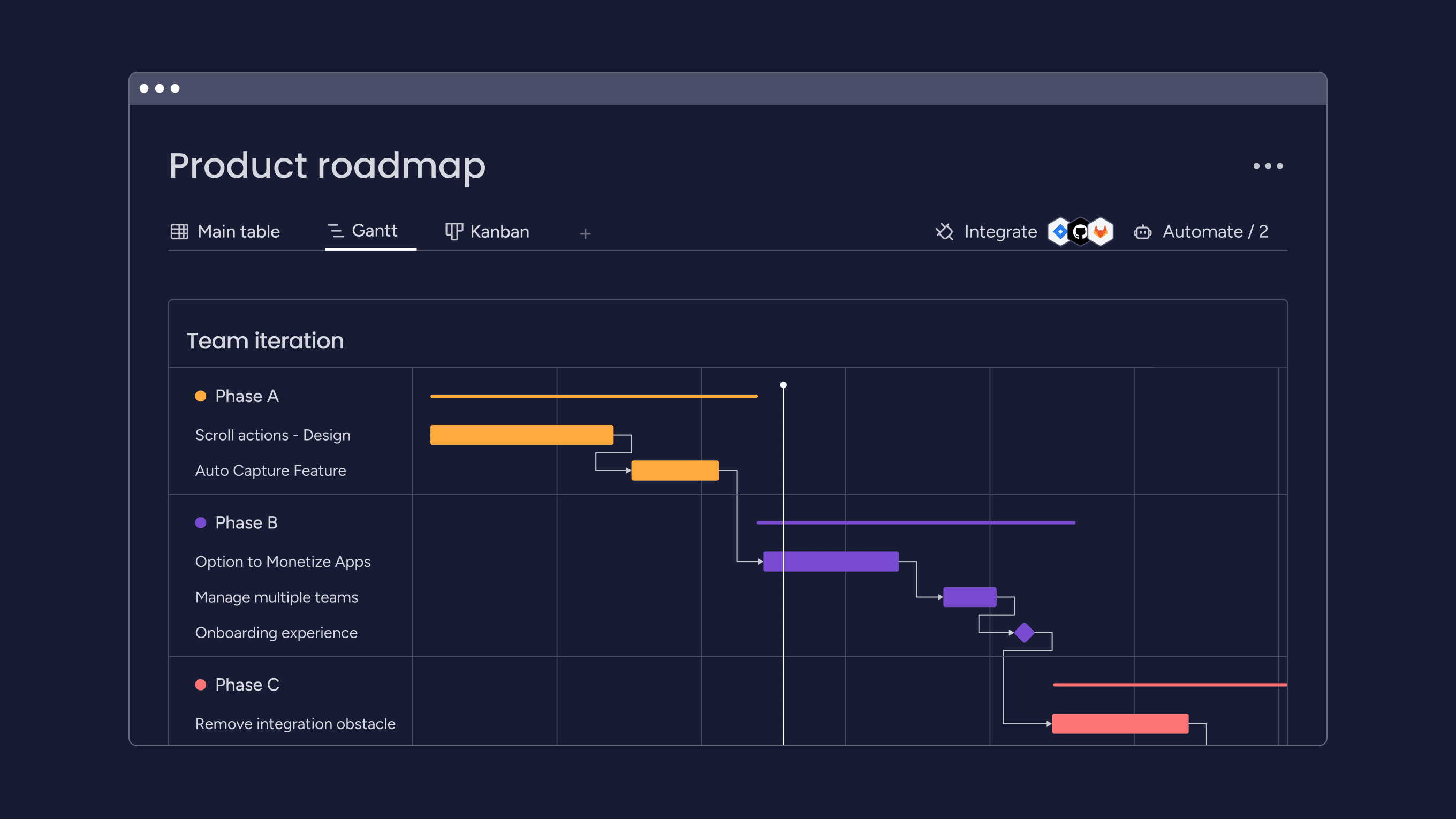Whether you’re overseeing a small startup crew or coordinating large-scale enterprise projects, effective leadership in software development is more crucial than ever. As technology evolves and project complexities increase, the challenges of guiding diverse talents, meeting tight deadlines, and delivering high-quality products remain constant.
In this guide, we’ll delve into the essential strategies for successfully managing software teams. From adopting the best methodologies to fostering a culture of continuous improvement, you’ll discover how to build, motivate, and lead high-performing software teams. We’ll also show you how monday dev can help manage your software development team.
Try monday devHow to manage your software team
Managing your software team effectively requires a combination of strategic approaches and modern tools. By implementing these strategies, you can effectively lead your software team and foster a productive, collaborative environment that drives success.
Build the foundation
Choose a structure that aligns with your project and business requirements. For example, you might need:
- Generalist teams: Suitable for small projects with low to medium complexity.
- Specialist teams: Ideal for niche products requiring high expertise.
- Hybrid teams: Combination of generalists and specialists for complex projects.
Then, define the roles and responsibilities. For example, if you use the Scrum framework, you’ll need product owners, certified Scrum masters, and a development team. Other roles you may need to fill include project managers, software architects, UI/UX designers, QA engineers, and business analysts.
Set expectations and goals
Whether your team works locally or remotely, establish clear goals and objectives early on. Define project requirements and team expectations to ensure everyone is aligned with the overall vision. Set realistic and achievable goals for each phase of the software development life cycle (SDLC).
Establish communication and collaboration
Prioritize effective communication among team members to promote trust and healthy conflict resolution. Foster open dialogue and create an environment where feedback and ideas are welcomed. Use a mix of collaboration tools, regular meetings, and clear messaging to keep everyone informed and connected. For example:
- Establish regular team meetings, like daily stand-ups and sprint retrospectives, to discuss objectives and progress.
- Use a mix of synchronous and asynchronous communication methods, leveraging video conferencing tools like Zoom and instant messaging platforms like Slack.
- Implement collaboration systems and tools that everyone can access and update, such as monday dev, Asana, Trello, or GitHub.
Adopt methodologies and best practices
Commit to a software development methodology that suits your team’s needs, such as Agile or Waterfall. Implement Agile methodologies for flexibility by adopting frameworks like Scrum or Kanban to boost efficiency and promote adaptability in your development process.
Implement best code review, testing, and deployment practices to ensure high-quality output. Embrace change management practices by implementing systems to track and supervise code changes and other critical development elements.
Manage tasks and resources
Prioritize tasks and manage workloads to maximize productivity and meet project deadlines. Use project management software like monday dev, Jira, Trello, or Asana to streamline processes, manage workflows, and track progress efficiently. Allocate resources wisely, for example, assigning designers and engineers to tasks according to their strengths and expertise.
Empower the team
Avoid micromanagement and trust your team to make decisions and solve problems independently while providing the necessary support. Handle non-technical tasks on behalf of your team by shielding your developers from administrative burdens and allowing them to focus on their core technical responsibilities.
Facilitate continuous improvement
Foster a culture of continuous learning and improvement. Encourage ongoing learning, knowledge sharing, and skill development to keep the team updated with the latest technologies and practices. Regularly seek feedback on processes and tools to keep the team growing and adapting. Use metrics to track team performance and productivity.
Provide support and recognition
Cultivating a positive work culture by motivating your team through recognition and support. Support team members, especially in remote environments, through regular one-on-one check-ins. Celebrate successes and project milestones, provide constructive feedback, and create a positive work environment to maintain team morale.
How to manage a software team if you don’t have technical experience
Managing a software team without technical experience can be challenging, but it’s entirely possible with the right approach. Here are key strategies for non-technical leaders to effectively manage software development teams while leveraging their unique strengths in business and leadership.
Focus on leadership and communication
Use the strategies from above to build and manage your team. For example:
- Establish clear goals and expectations for the team by defining project requirements and aligning them with business objectives.
- Foster open and frequent communication through regular check-ins and stand-ups to discuss technical progress in business terms.
- Create a positive work environment that encourages creativity and problem-solving without micromanaging.
Leverage your strengths
Even though you may not be tech-savvy, you have other skills to bring to the table. For instance, you can:
- Bring a broader business perspective to projects by focusing on business impact and customer needs rather than only technical details.
- Prioritize soft skills development and professional growth for your team to help bridge the gap between technical and non-technical aspects of a project.
- Use your business acumen to align projects with company goals.
Educate yourself and trust your experts
When I started managing a team of Oracle software engineers, I leaned on their expertise to help me understand the product better and bridge the gap between technical jargon and customer needs. You can:
- Commit to learning basic concepts and terminology relevant to your team’s work. Attend beginner-level webinars or conferences to enhance your understanding.
- Rely on technical leads or senior developers to bridge knowledge gaps. They can help translate complex technical concepts into business language.
- Trust your experts, but verify. Encourage your tech team to flag potential issues early and bring concerns to you.
Implement effective management practices
Use the best available tools and proven practices to manage the team effectively. For example:
- Adopt Agile methodologies to enhance flexibility and efficiency. Focus on outcomes rather than outputs, and be open to pivoting when necessary.
- Use project management tools to track progress and manage workflows. This helps you stay informed about project status without needing deep technical knowledge.
- Measure performance based on a mix of quality, quantity, and collaboration rather than just lines of code written.
Considerations when managing a remote software team
The earlier strategies hold true for managing remote, hybrid, and local teams. By addressing these considerations, you can effectively manage your remote software team, ensuring productivity, engagement, and successful project outcomes.
Clarify expectations
- Clearly define roles, responsibilities, and deliverables using tools like monday dev to create roadmaps and track tasks, deadlines, and progress.
- Set SMART goals (Specific, Measurable, Achievable, Relevant, Time-bound) to align individual and team efforts with company objectives.
- Establish guidelines and standard operating procedures (SOPs) for work hours, availability, and communication protocols to eliminate ambiguity and foster accountability.
Establish regular communication
- Use consistent communication channels, like Slack for instant messaging and Zoom for video conferencing.
- Establish clear communication guidelines, including response times and preferred channels for different types of information.
- Utilize asynchronous communication methods to accommodate different time zones and work schedules.
Build team culture and engagement
- Foster a culture of transparency and accountability.
- Schedule regular check-ins and virtual team meetings to maintain connection.
- Encourage open feedback and input from team members on work practices.
Leverage tools and technology
- Provide necessary resources, including software, hardware, and training opportunities, to help team members succeed.
- Use product management tools like monday dev to track progress, manage workflows, and centralize updates.
- Use collaborative software that allows real-time document sharing and editing.
Maintain work-life balance
- Respect different time zones and work schedules when setting meetings.
- Promote a healthy work-life balance by setting clear boundaries for work hours.
- Focus on deliverables and results, like milestones achieved or code quality, to measure success rather than monitoring activity or hours worked.
How monday dev can help you manage your software team
Built on the robust monday.com Work OS, monday dev gives you the flexibility and freedom to manage your software team with full visibility, seamless integration, and complete ownership — all while aligning with business strategy. Here’s how you can use it to manage your software team.
- Roadmap planning: Use product roadmaps to visualize and manage your team’s long-term plans, ensuring alignment with business goals.

- Collaboration and communication: Keep all project-related information in one place, enhancing collaboration and reducing communication overhead.

- Sprint management and automations: Break down large projects into manageable sprints and automate routine tasks to save time and reduce manual effort.

- Integration with development tools: Seamlessly integrate with tools like GitHub and CircleCI to track code updates and automate testing and deployment directly from one platform.

- Bug tracking and task management: Use AI for software engineering to efficiently categorize, report, track, and assign bugs and notify engineers of new tasks in their queue to ensure timely resolution.
- Agile insights: Track sprint progress with Burndown charts to identify potential bottlenecks early.

- Performance monitoring: Track team performance metrics on customizable dashboards to identify areas for improvement and optimize workflows.

- Development focus: Leverage fast AI automations so software teams can prioritize coding and engineering work, rather than managing task statuses or providing manual updates.

But don’t just take our word for it — experience monday dev yourself with a free trial and see how you can manage your software team efficiently and effectively.
Try monday devFAQs
How do you structure a software team?
Structuring a software team involves choosing between three main approaches: generalist, specialist, or hybrid. Generalist teams consist of versatile members suited for smaller projects, specialist teams comprise experts for complex, niche projects, and hybrid teams combine both to balance flexibility and expertise. The choice depends on project complexity, budget constraints, and organizational needs, with each structure offering unique advantages in terms of adaptability, depth of knowledge, and scalability.
What are the 7 steps of software development?
The seven steps of software development typically include planning, analysis, design, implementation (coding), testing, deployment, and maintenance. These stages form a structured approach to creating software, starting with defining requirements and project scope, progressing through the actual development and testing phases, and concluding with the release and ongoing support of the software product. This process ensures a systematic and comprehensive approach to software development, addressing all aspects from initial concept to long-term maintenance.
What is team management software?
Team management software is an organizational tool that supports team collaboration and productivity. It provides features such as task management, real-time communication, resource allocation, and performance tracking, allowing teams to work efficiently and managers to monitor progress effectively. These tools centralize workflows, enhance collaboration, and offer insights into team performance, helping organizations achieve their goals more efficiently.
 Get started
Get started



